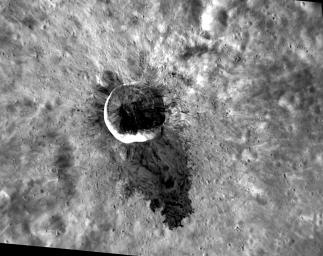
|
Wonder at Waters
- Click the image above for a larger view
- Full-Res JPEG (1285 x 1017) (212.6 kB)
- Full-Res TIFF (1285 x 1017) (1.3 MB)
Caption:
Ever since MESSENGER entered orbit about Mercury in 2011, the dark impact melt flow of Waters crater has been a feature of interest. Targeted color imaging showed the distinctive blue color of the impact melt flow, inspiring the crater to be named for blues legend Muddy Waters in 2012. In 2013, this high-resolution image was acquired, revealing stunning new details of the impact melt flow beyond those visible previously .
This image was acquired as a targeted set of stereo images. Targeted stereo observations are acquired at resolutions much higher than that of the 200-meter/pixel stereo base map. These targets acquired with the NAC enable the detailed topography of Mercury's surface to be determined for a local area of interest.
Date acquired:
September 16, 2013
Image Mission Elapsed Time (MET):
21673915
Image ID:
4834878
Instrument:
Narrow Angle Camera (NAC) of the Mercury Dual Imaging System (MDIS)
Center Latitude:
-9.00°
Center Longitude:
254.7° E
Resolution:
56 meters/pixel
Scale:
Waters crater is 15 kilometers (9 miles) in diameter
Incidence Angle:
44.0°
Emission Angle:
44.8°
Phase Angle:
85.5°
Background Info:
The MESSENGER spacecraft is the first ever to orbit the planet Mercury, and the spacecraft's seven scientific instruments and radio science investigation are unraveling the history and evolution of the Solar System's innermost planet. MESSENGER acquired over 150,000 images and extensive other data sets. MESSENGER is capable of continuing orbital operations until early 2015.
For information regarding the use of images, see the MESSENGER image use policy .
Cataloging Keywords:
| Name | Value | Additional Values |
|---|---|---|
| Target | Mercury | |
| System | ||
| Target Type | Planet | |
| Mission | MESSENGER | |
| Instrument Host | MESSENGER | |
| Host Type | Orbiter | |
| Instrument | Mercury Dual Imaging System (MDIS) | |
| Detector | Narrow Angle Camera (NAC) | |
| Extra Keywords | Crater, Grayscale, Impact, Map, Radio, Water | |
| Acquisition Date | ||
| Release Date | 2014-04-23 | |
| Date in Caption | 2013-09-16 | |
| Image Credit | NASA/Johns Hopkins University Applied Physics Laboratory/Carnegie Institution of Washington | |
| Source | photojournal.jpl.nasa.gov/catalog/PIA18228 | |
| Identifier | PIA18228 | |
